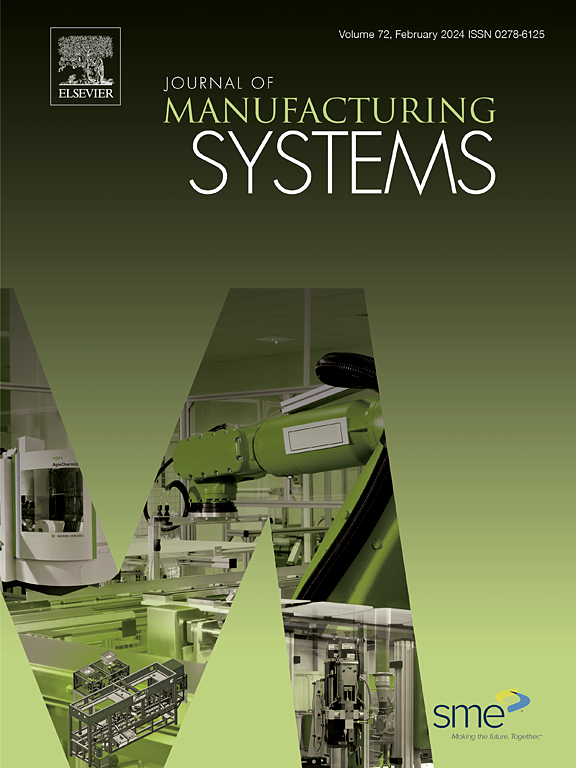一种估算数字孪生体成本的方法
IF 12.2
1区 工程技术
Q1 ENGINEERING, INDUSTRIAL
引用次数: 0
摘要
本文提出了一种估算制造过程中开发数字孪生(DTs)成本的方法。它制定了一个成本模型,确定了主要的成本要素,并提出了基于一组给定的物理信息实体作为DT输入来建立可接受的成本参考的估计过程。为了实现这一目标,从ISO 23247 DT参考框架和数字孪生数据概念衍生出六个核心数据活动,从数据角度描述DT的功能。这些活动包括数据收集、数据交互、数据存储、数据处理、数据服务化和数据维护。作业成本法(作业成本法)应用于在开发DTs(人员、机器、设备、材料、设施和服务)的过程中为这些数据密集型活动分配六种资源。由此产生的成本结构包括40个成本活动,以及相关的定量度量。这项工作提出了一个关于开发用于估计MEX过程中尺寸精度的DT的案例研究,其中考虑了热和加速度测量。对于具有挤出机和构建板温度以及X轴和y轴加速度的信息集,开发DT的成本估计在4780英镑(一个温度信号)和39,285英镑(两个温度信号和两个加速度信号)之间,为期两年的服务和一年的数据存档。此外,还分析了四个类别(IT基础设施、资源、数据活动和投资)的成本分布。派生的见解可以支持与成本相关的分析、物理信息实体选择、预算控制和DT成本的标准开放数据库。本文章由计算机程序翻译,如有差异,请以英文原文为准。
A methodology for estimating the cost of a digital twin
This paper proposes a methodology for estimating the cost of developing digital twins (DTs) in manufacturing processes. It formulates a cost model that identifies main cost elements and presents the estimation process for establishing an acceptable cost reference based on a given set of physical information entities as DT inputs. To achieve this, six core data activities are derived from the ISO 23247 DT reference framework and the Digital Twin Data concept to characterize the functioning of DTs from a data perspective. These activities are data gathering, data interaction, data storage, data processing, data servitization, and data maintenance. The activity-based costing (ABC) method is applied to allocate six resources in the development of DTs (personnel, machine, equipment, material, facility, and service) to these data-intensive activities. The resultant cost structure comprises 40 cost activities, along with associated quantitative metrics. This work presents a case study on developing a DT for estimating the dimensional accuracy in the MEX process, where thermal and acceleration measurements are considered. For the information set with extruder and build plate temperatures as well as X- and Y-axis acceleration, developing a DT is estimated to cost between £4780 (for one temperature signal) and £39,285 (for two temperature signals and two acceleration signals) for two years of service and one year of data archiving. In addition, the cost distribution across four categories (IT infrastructure, resource, data activity, and investment) are analysed. The derived insights can support cost-related analysis, physical information entity selection, budget control, and standard open databases for DT costs.
求助全文
通过发布文献求助,成功后即可免费获取论文全文。
去求助
来源期刊

Journal of Manufacturing Systems
工程技术-工程:工业
CiteScore
23.30
自引率
13.20%
发文量
216
审稿时长
25 days
期刊介绍:
The Journal of Manufacturing Systems is dedicated to showcasing cutting-edge fundamental and applied research in manufacturing at the systems level. Encompassing products, equipment, people, information, control, and support functions, manufacturing systems play a pivotal role in the economical and competitive development, production, delivery, and total lifecycle of products, meeting market and societal needs.
With a commitment to publishing archival scholarly literature, the journal strives to advance the state of the art in manufacturing systems and foster innovation in crafting efficient, robust, and sustainable manufacturing systems. The focus extends from equipment-level considerations to the broader scope of the extended enterprise. The Journal welcomes research addressing challenges across various scales, including nano, micro, and macro-scale manufacturing, and spanning diverse sectors such as aerospace, automotive, energy, and medical device manufacturing.
 求助内容:
求助内容: 应助结果提醒方式:
应助结果提醒方式:


